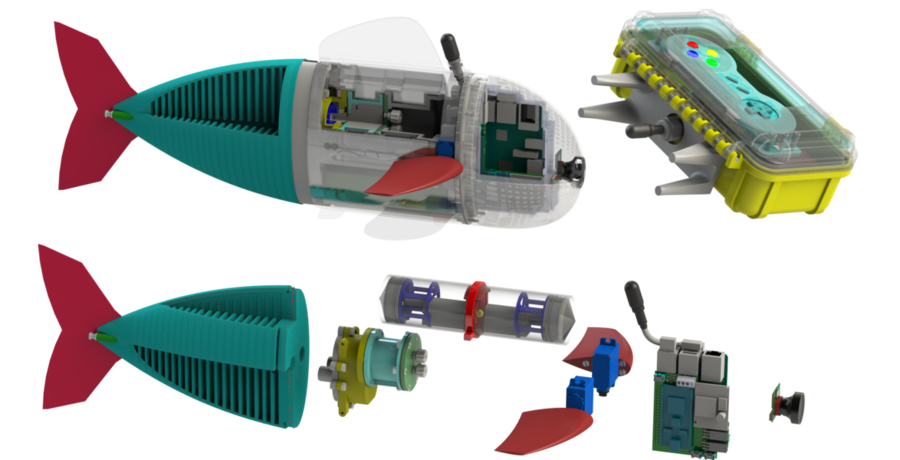This month scientists published rare footage of one of the Arctic’s most elusive sharks. The findings demonstrate that, even with many technological advances in recent years, it remains a challenging task to document marine life up close.
But MIT computer scientists believe they have a possible solution: using robots.
In a paper out today, a team from MIT’s Computer Science and Artificial Intelligence Laboratory (CSAIL) unveiled “SoFi,” a soft robotic fish that can independently swim alongside real fish in the ocean.
During test dives in the Rainbow Reef in Fiji, SoFi swam at depths of more than 50 feet for up to 40 minutes at once, nimbly handling currents and taking high-resolution photos and videos using (what else?) a fisheye lens.
Using its undulating tail and a unique ability to control its own buoyancy, SoFi can swim in a straight line, turn, or dive up or down. The team also used a waterproofed Super Nintendo controller and developed a custom acoustic communications system that enabled them to change SoFi’s speed and have it make specific moves and turns.
“To our knowledge, this is the first robotic fish that can swim untethered in three dimensions for extended periods of time,” says CSAIL PhD candidate Robert Katzschmann, lead author of the new journal article published today in Science Robotics. “We are excited about the possibility of being able to use a system like this to get closer to marine life than humans can get on their own.”
Katzschmann worked on the project and wrote the paper with CSAIL director Daniela Rus, graduate student Joseph DelPreto and former postdoc Robert MacCurdy, who is now an assistant professor at the University of Colorado at Boulder.
How it works
Existing autonomous underwater vehicles (AUVs) have traditionally been tethered to boats or powered by bulky and expensive propellers.
In contrast, SoFi has a much simpler and more lightweight setup, with a single camera, a motor, and the same lithium polymer battery that’s found in consumer smartphones. To make the robot swim, the motor pumps water into two balloon-like chambers in the fish’s tail that operate like a set of pistons in an engine. As one chamber expands, it bends and flexes to one side; when the actuators push water to the other channel, that one bends and flexes in the other direction.
These alternating actions create a side-to-side motion that mimics the movement of a real fish. By changing its flow patterns, the hydraulic system enables different tail maneuvers that result in a range of swimming speeds, with an average speed of about half a body length per second.
“The authors show a number of technical achievements in fabrication, powering, and water resistance that allow the robot to move underwater without a tether,” says Cecilia Laschi, a professor of biorobotics at the Sant'Anna School of Advanced Studies in Pisa, Italy. “A robot like this can help explore the reef more closely than current robots, both because it can get closer more safely for the reef and because it can be better accepted by the marine species.”
The entire back half of the fish is made of silicone rubber and flexible plastic, and several components are 3-D-printed, including the head, which holds all of the electronics. To reduce the chance of water leaking into the machinery, the team filled the head with a small amount of baby oil, since it’s a fluid that will not compress from pressure changes during dives.
Indeed, one of the team’s biggest challenges was to get SoFi to swim at different depths. The robot has two fins on its side that adjust the pitch of the fish for up and down diving. To adjust its position vertically, the robot has an adjustable weight compartment and a “buoyancy control unit” that can change its density by compressing and decompressing air.
Katzschmann says that the team developed SoFi with the goal of being as nondisruptive as possible in its environment, from the minimal noise of the motor to the ultrasonic emissions of the team’s communications system, which sends commands using wavelengths of 30 to 36 kilohertz.
“The robot is capable of close observations and interactions with marine life and appears to not be disturbing to real fish,” says Rus.
The project is part of a larger body of work at CSAIL focused on soft robots, which have the potential to be safer, sturdier, and more nimble than their hard-bodied counterparts. Soft robots are in many ways easier to control than rigid robots, since researchers don’t have to worry quite as much about having to avoid collisions.
“Collision avoidance often leads to inefficient motion, since the robot has to settle for a collision-free trajectory,” says Rus, the Andrew and Erna Viterbi Professor of Electrical Engineering and Computer Science at MIT. “In contrast, a soft robot is not just more likely to survive a collision, but could use it as information to inform a more efficient motion plan next time around.”
As next steps the team will be working on several improvements on SoFi. Katzschmann plans to increase the fish’s speed by improving the pump system and tweaking the design of its body and tail.
He says that they also plan to soon use the on-board camera to enable SoFi to automatically follow real fish, and to build additional SoFis for biologists to study how fish respond to different changes in their environment.
“We view SoFi as a first step toward developing almost an underwater observatory of sorts,” says Rus. “It has the potential to be a new type of tool for ocean exploration and to open up new avenues for uncovering the mysteries of marine life.”
This project was supported by the National Science Foundation.













